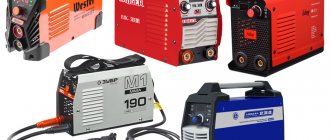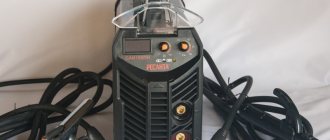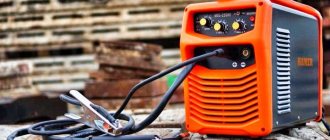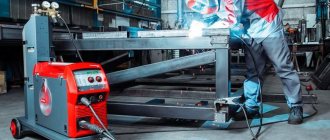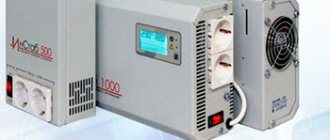To choose the right equipment for welding work, you need to know the design and operating principle of the welding inverter. If you have a good understanding of such issues, you can not only effectively use, but also repair inverter devices yourself.
Inverter welding machines made in Italy
There are many models of inverters offered on the modern market, which allows professionals to select equipment in accordance with their needs and financial capabilities. If you want to save money, you can make an inverter welding machine with your own hands.
Operating principle of the inverter
As already noted, inverters entered the practice of welding not so long ago, at the end of the twentieth century. The operation of devices of this type is based on the principle of voltage shift. This solution allows you to increase the strength and frequency of the current. It should be noted that the device of the inverter used for the work contains a rather complex circuit, within which the following processes are implemented:
Inverter welding machines
- The alternating current supplied to the inverter is converted to direct current. The change in current parameters occurs in the device, which is assembled using a diode bridge.
- The resulting current is transmitted to the inverter, which plays the role of a high-frequency pulse generator. In the transistor unit, the reverse conversion of direct current to alternating current occurs. But the resulting current has a significantly higher frequency than that coming from the power supply.
- High frequency current is supplied to the transformer. This device reduces the voltage and simultaneously increases the current. Since the transformer, which is used to work with high-frequency currents, has small dimensions, all this affects the overall weight characteristics of the inverter.
- After passing through the transformer, alternating current with new parameters is supplied to the rectifier, where it is again transformed into direct current, which is used for welding.
Welding with an inverter for beginners
It should be noted that inverter devices, unlike transformer-type devices, consume half the amount of energy. In addition, the parameters of the current that comes from the device ensure that the welding arc will have stable ignition and combustion during welding.
Transformer
Today, this is the simplest power source for a welding arc that produces only alternating current at the output.
Smooth control of the welding current is carried out by changing the gap in the choke coil or between the windings. Stepped - by switching the number of turns of the primary and secondary windings.
Transformers are very simple, which makes it possible to make it yourself. Currently, transformers are not relevant. This is due to the fact that direct current does not provide a stable arc, and its use when welding stainless steels is impossible.
Technical parameters of devices
Welding inverters have a number of specific characteristics by which one can judge its technological properties. These include the following parameters:
Welding inverter design
- The type of current that is generated at the output of the rectifier.
- The amount of voltage that is used to supply electricity. Manufacturers produce products that operate on 380 and 220 V. The former are used for professional welding, the latter for work at home.
- Current size, this parameter has a direct impact on the size of the electrode that will be used to perform the weld.
Technical parameters of welding inverter
- Unit power, this parameter provides information about the current and strength that will form the welding arc.
- Open circuit voltage, this parameter shows how quickly the welding arc will be produced.
- The range of electrode sizes that will be used for welding.
- Dimensional and weight characteristics of the inverter welding machine and the size of the welding current at the output. The lower the last indicator, the smaller the device, but accordingly such a device has lower performance characteristics.
Converter
The work of the converter is to convert the alternating current of the network into the mechanical energy of an electric motor. As a result of rotation of the generator shaft, mechanical energy is converted into direct current electrical energy.
A big advantage is the insensitivity to voltage drops, so the output produces a direct current with a stable current-voltage characteristic.
Due to their large mass, they are almost always made stationary. The downside is low efficiency and high wear on moving parts.
At the moment, converters have lost their relevance.
Pros and cons of inverter welding
Inverter devices show efficiency in the range of 85 - 95%, I must say that this is a high figure among electronic equipment. The circuit used allows you to adjust the level of welding current from several amperes to hundreds, or even thousands.
For example, an inverter of the MMA brand, it is 20 - 220 A. Inverters can operate for a long time. The power supply can be controlled remotely. The undoubted advantages of inverters include their small size and weight characteristics, which allow the device to be moved at the welding site. The design of the devices uses double insulation, ensuring electrical safety.
Technological advantages
The use of inverters allows the use of electrodes of any brand that work with both direct and alternating current. Devices of this type can be used for welding with a non-consumable electrode in a shielding gas environment. In addition, the design of this equipment makes it easy to automate welding processes.
Tungsten electrodes for argon arc welding
Electrodes for resistance welding
Welding can be performed using a short arc, thus reducing energy losses and increasing the quality of the weld; in particular, there is virtually no welding spatter on the surface of the parts being welded. By the way, the use of inverters allows you to produce seams in any spatial configuration.
Microprocessor
Microprocessors are used to control modern welding inverters, and this ensures a stable connection between voltage and current.
Disadvantages of inverters
Inverters are somewhat more difficult to repair than traditional transformer units. If some control elements located on the board fail, repairs can cost about a third of the cost of a new welding inverter.
Inverters, unlike other types of equipment, are very susceptible to dust. That is, such devices must be serviced more often. Operation of an inverter welding machine is also limited by low temperatures. In addition, there are some restrictions on storing the inverter at sub-zero temperatures. This is fraught with the formation of condensation, which can lead to a short circuit on the board.
Rectifier
Converts alternating current of industrial frequency into direct current, necessary for welding.
Rectifiers are single-phase and three-phase, stationary or mobile. Have the ability to change the current-voltage characteristic to hard or falling, as well as polarity when welding.
Smooth regulation of the welding current is carried out by the control unit, and stepwise regulation by switching the windings.
Their widespread use in production speaks of their versatility and productivity. High efficiency and the ability to be used when welding various metals make them one of the most popular power sources.
How to choose a 220 V welding machine for home and garden
When selecting welding equipment, the consumer must decide what tasks it will be needed for.
If it is used for repairing body parts, then it should have some parameters, and if it is used for the production of metal structures, then it should have different parameters. But in any case, the devices must meet a number of requirements, in particular, functions such as hot start, anti-sticking and some others must be implemented in a home device. This is how inverters differ from traditional devices.
A fan must be installed in the design of this type of device. In addition, the circuit must be protected from power surges. In principle, a device with such parameters can work both in a home workshop and in industrial production conditions.
Inverter classification
Welding inverters can be classified by the size of the welding current. Manufacturers produce three types of devices:
- 100-160 A – low-power;
- 160-200 A - average;
- 200-250 A - powerful.
There is a relationship between the size of the current and the dimensions of the device. When choosing a device for use at home, you should be guided by the tasks that they have to solve.
The weakest devices can be classified as devices of the lowest level; many use them to gain work skills. Devices that are classified as middle class are among the most popular and allow you to perform a wide variety of work, from assembling a fence and manufacturing quite complex metal structures. The most powerful devices are mostly used for production purposes. They are used for working with rolled metal of large thickness.
Electrodes for manual arc welding
Most inverters are designed to work with coated electrodes. But they can also be used to work with welding wire. To do this, a device is installed on the device that feeds the wire into the welding zone. The wire is fed through the welding gun, and the gas mixture is also fed through it, protecting the working area from exposure to atmospheric air.
Additional functions in inverters
Modern inverter devices implement some options that significantly facilitate the welder’s work:
- Hot start - often novice welders, and not only them, have difficulty igniting and maintaining the arc in working condition. At the moment of ignition, the current rises to the required level and immediately after ignition returns to operating parameters. The process of changing the current occurs completely automatically, without the participation of the welder.
- Another problem that plagues beginners is electrode sticking. There are several reasons for this, but there is only one solution - reducing the level of welding current. This operation is also performed automatically.
- Arc forcing allows you to make seams in different spatial positions.
- Reducing the no-load voltage to a level that is safe for the worker and his surrounding people.
Determining the characteristics
Like any technical equipment, welding inverters have a number of technical parameters that determine their capabilities.
Welding current
Inverter welding machines provide the generation of welding current in the range from 100 to 250 A.
Open circuit voltage
After converting the current supplied from the electrical network to 220 V, a current with a voltage of 50 - 90 V and an operating frequency of 20 - 50 kHz is obtained at the output of the device. Maximum voltage must be used to ignite the arc, but this creates a safety hazard for the welder and surrounding people. Therefore, after finishing work, the voltage drops to a safe level.
Maximum current operating mode
An important indicator of the operation of any welding machine is the operating time. It may be called PN or PV. This indicator indicates how long the device will operate with a ten-minute welding cycle before shutting down.
In other words, if the duty cycle is 50%, this means that the effective operating time will be 5 minutes, if the indicator is 70%, then the time will be 7 minutes. This indicator must be reflected in the technical documentation included in the delivery of the welding machine.
Which inverter to choose for home use
To choose a suitable welding inverter, you must first decide what it is supposed to do and under what conditions it will be used.
Based on these data, it is already possible to select power, operating modes and other technical characteristics of the future device. A home craftsman for household needs is unlikely to require such types of welding as MIG/MAG and TIG, so further we will talk only about manual MMA electric arc welding. In order to qualitatively weld angles, channels, strips and pipes up to 5 mm thick, theoretically, a welding inverter with the following characteristics is sufficient:
- mains voltage - 220 V;
- maximum welding current - 120÷150 A;
- PV - 40÷50%;
- electrode thickness - up to 4÷5 mm.
But in practice, the operation of the inverter will most likely occur under conditions different from the standard ones. Therefore, you will almost certainly have to adjust the selected characteristics. First of all, you should analyze the quality and stability of the supply voltage. Typically, welding inverters are designed to operate in conditions of input voltage fluctuations of ±10÷15%, so when connected to an electrical network with such parameters, they will work without any problems. If the deviation reaches 30% (which often happens in dachas, garages and rural areas), then you should choose an inverter model with the ability to operate at reduced voltage.
It must be remembered that the inverter power and welding current will drop in proportion to the decrease in voltage. It should also be taken into account that the use of welding wires longer than five meters (which will certainly be required when welding outdoors) also reduces its power. Therefore, it is necessary to choose a device with a current reserve. In our case, the optimal device would be a maximum current of 160÷180 A.
A home inverter should be lightweight so that it is easy to carry, and compact so that it fits in the trunk of a car. It is advisable to choose an inverter with a shock-resistant and waterproof housing, as well as a transparent protective cover for the control panel. The presence of a digital indicator is desirable, but not necessary, since on inexpensive models they often work with large errors.
Almost all modern inverters (even in the price category up to 10 thousand rubles) are standardly equipped with the Arc Force, Anti stick and Hot start functions. But when choosing a specific model, you should still make sure that these modes are available.
Figure 8 - Welding process
The technical requirements for choosing the best home welding inverter in our version will look something like this:
| № | Name | Household |
| 1 | Input voltage (V) | 220 |
| 2 | Allowable voltage fluctuations (%) | +15 / -40 |
| 3 | Power, kWt) | 4÷5 |
| 4 | Max. and min. operating current values (A) | 10÷180 |
| 5 | Open circuit voltage (V) | 60÷80 |
| 6 | Degree of protection | IP-22 |
| 7 | Electrode diameter (mm) | 1.6÷5.0 |
| 8 | Duration of switching on (duty cycle, %) | 30÷50 |
| 9 | Additional functions | Arc Force, Anti stick, Hot start |
| 10 | Weight, kg) | 4÷5 |
When choosing a specific model, you should focus on well-known brands that have been on the market for at least ten years. It is also necessary to pay attention to the proximity of the service center and the warranty period, which for inverter manufacturers ranges from one to five years.
